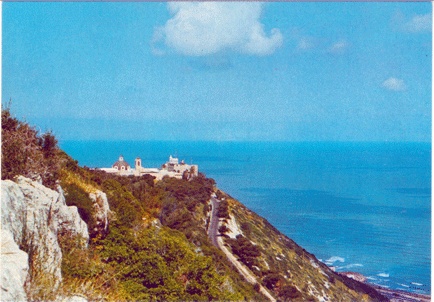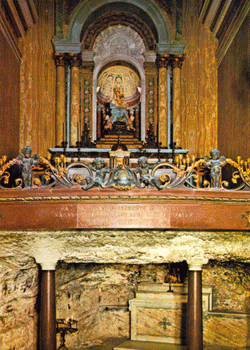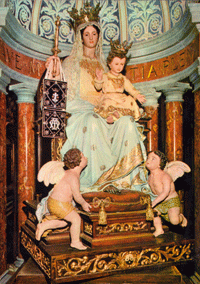

The Stella Maris Monastery on Mt. Carmel overlooks the sea where Elias saw the prophetic cloud.
When Eternal Wisdom was playing in the world, forming the hills and establishing the mountains, He destined Mount Carmel to be the special inheritance of Eve's victorious Daughter, the Blessed Virgin Mary. And when the last thousand years of expectation were opening, and the desire of all nations was developing into the spirit of prophecy, the father of the prophets ascended the privileged mount, thence to scan the horizon. The triumphs of David and the glories of Solomon were at an end: the scepter of Juda, broken by the schism of the ten tribes, threatened to fall from his hand; the worship of Baal prevailed in Israel. A long-continued drought, figure of the aridity of men's souls, had parched up every spring, and men and beasts were dying beside the empty cisterns, when Elias the Thesbite gathered the people, representing the whole human race, on Mount Carmel, and slew the lying prophets of Baal. Then, as the Scripture relates, prostrating with his face to the earth, he said to his servant: Go up, look towards the sea. And he went up, and looked and said: There is nothing. And again he said to him: Return seven times. And at the seventh time: Behold, a little cloud arose out of the sea like a man's foot (3 Kings 18).
Blessed cloud! unlike the bitter waves from which it sprang, it was all sweetness. Docile to the least breath of Heaven, it rose light and humble, above the immense heavy ocean; and screening the sun, it tempered the heat that was scorching the earth and restored to the stricken world life and grace and fruitfulness. The promised Messias, the Son of Man, set His impress upon it, showing to the wicked serpent the form of the heel that was to crush him. The prophet, personifying the human race, felt his youth renewed; and while the welcome rain was already refreshing the valleys, he ran before the chariot of the king of Israel. Thus did he traverse the great plain of Esdrelon, even to the mysteriously named town of Jezrahel, where, according to Osee, the children of Juda and Israel were again to have but one head in the great day of Jezrahel (i.e. of the seed of God), when the Lord would seal His eternal nuptials with a new people (Osee 1: 11; 2: 14-24). Later on, from Sunam near Jezrahel, the mother whose son was dead crossed the same plain of Esdrelon, in the opposite direction, and ascended Mount Carmel, to obtain from Eliseus the resurrection of her child, who was a figure of us all (4 Kings 4: 8-37). Elias had already departed in the chariot of fire, to await the last age of the world, when he is to give testimony, together with Henoch, to the Son of Her that was signified by the cloud (Apoc. 11: 3, 7); and the disciple, clothed with the mantle and spirit of his father, had taken possession, in the name of the sons of the prophets, of the august mountain honored by the manifestation of the Queen of Prophets. Henceforward Carmel was sacred in the eyes of all who looked beyond this world. Gentiles as well as Jews, philosophers and princes, came here on pilgrimage to adore the true God; while the chosen souls of the Church of the expectation, many of whom were already wandering in deserts and in mountains (Heb. 11:38), loved to take up their abode in its thousand grottos; for the ancient traditions seemed to linger more lovingly in its silent forests, and the perfume of its flowers foretokened the Virgin Mother. The devotion to the Queen of Heaven was already established; and to the family of Her devout clients, the ascetics of Carmel, might be applied the words spoken later by God to the pious descendants of Rechab: There shall not be wanting a man of this race, standing before Me forever (Jerem. 35:19).

The High Altar of Our Lady of Mt. Carmel with the Cave of St. Elias beneath.
At length figures gave place to the reality; the heavens dropped down their dew, and the Just One came forth from the cloud. When His work was done and He returned to His Father, leaving His Blessed Mother in the world, and sending the Holy Ghost to the Church, not the least triumph of that Spirit of love was the making known of Mary to the new-born Christians of Pentecost. What a happiness for those neophytes who were privileged above the rest in being brought to the Queen of Heaven, the Virgin Mother of Him Who was the Hope of Israel! They saw this Second Eve, they conversed with Her, they felt for Her that filial affection wherewith She inspired all the disciples of Jesus. In the lessons of the Feast, the Church tells us how the disciples of Elias and Eliseus became Christians at the first preaching of the Apostles, and being permitted to hear the sweet words of the Blessed Virgin and enjoy an unspeakable intimacy with Her, they felt their veneration for Her immensely increased. Returning to the beloved mountain, where their less fortunate fathers had lived but in hope, they built, on the very spot where Elias had seen the little cloud rise up out of the sea, an oratory to the Purest of Virgins; hence they obtained the name of Brothers of Blessed Mary of Mount Carmel.
In the 12th century, in consequence of the establishment of the Latin Kingdom of Jerusalem, many pilgrims from Europe came to swell the ranks of the solitaries on the holy mountain; it therefore became expedient to give to their hitherto eremitical life a form more in accordance with the habits of Western nations. The legate Aimeric Malafaida, Patriarch of Antioch, gathered them into a community under the authority of St. Berthold, who was thus the first to receive the title of Prior-General. At the commencement of the next century, Blessed Albert, Patriarch of Jerusalem and also apostolic legate, completed the work of Aimeric by giving a fixed Rule to the Order, which was now, through the influence of princes and knights returned from the Holy Land, beginning to spread into Cyprus, Sicily, and the countries beyond the sea. Soon, indeed, the Christians of the East being abandoned by God to the just punishment of their sins, the vindictiveness of the conquering Saracens reached such a height in this age of trial for Palestine, that a full assembly, held on Mount Carmel under Alan the Breton, resolved upon a complete migration, leaving only a few friars eager for martyrdom to guard the cradle of the Order. The very year in which this took place (1245), St. Simon Stock was elected General in the first Chapter of the West, held at Aylesford in England.
St. Simon owed his election to the successful struggle he had maintained for the recognition of the Order, which certain prelates, alleging the recent decrees of the Lateran Council, rejected as having been newly introduced into Europe. Our Lady had then taken the cause of the friars into Her own hands, and had obtained from Pope Honorius III the decree of confirmation, which originated today's Feast. This was neither the first nor the last favor bestowed by the sweet Virgin upon the family that had lived so long under the shadow, as it were, of Her mysterious cloud, and shrouded like Her in humility, with no other bond, no other pretension than the imitation of Her hidden works and the contemplation of Her glory. She Herself had wished them to go forth from the midst of a faithless people; just as, before the close of that same 13th century, She would command Her angels to carry into a Catholic land Her blessed home of Nazareth. Whether or not the men of those days, or the short-sighted historians of our own time, ever thought of it, the one translation called for the other, just as each completes and explains the other, and each was to be for Europe the signal for wonderful favors from Heaven.
In the night between the 15th and 16th of July of the year 1251, the gracious Queen of Carmel confirmed to Her sons by a mysterious sign the right of citizenship She had obtained for them in their newly adopted countries; as Mistress and Mother of the entire religious state She conferred upon them with Her queenly hands the Scapular, hitherto the distinctive garb of the greatest and most ancient religious family of the West. On giving St. Simon Stock this badge, ennobled by contact with Her sacred fingers, the Mother of God said to him: "Whosoever shall die in this habit shall not suffer eternal flames." But not against hellfire alone was the all-powerful intercession of the Blessed Mother to be felt by those who should wear Her Scapular. In 1316, when every holy soul was imploring Heaven to put an end to that long and disastrous widowhoood of the Church, which followed on the death of Pope Clement V, the Queen of Saints appeared to James d'Euse, whom the world was soon to hail as Pope John XXII; She foretold to him his approaching elevation to the Sovereign Pontificate, and at the same time recommended him to publish the privilege She had obtained from Her Divine Son for Her children of Carmel—viz., a speedy deliverance from Purgatory. "I, their Mother, will graciously go down to them on the Saturday after their death, and all whom I find in Purgatory I will deliver and will bring to the mountain of life eternal." These are the words of Our Lady Herself, quoted by Pope John XXII in the Bull which he published for the purpose of making known the privilege, and which was called the Sabbatine Bull on account of the day chosen by the glorious Benefactress for the exercise of Her mercy.
There have been, of course, attempts made to cast doubt on the authenticity of these heavenly concessions. The attack of the chief assailant, the too famous Launoy, was condemned by the Apostolic See; and after, as well as before, these contradictions, the Roman Pontiffs confirmed, as much as need be, by their Supreme Authority, the substance and even the letter of the precious promises. The Popes have, time after time, enriched the Carmelite family with indulgences, as if earth would vie with Heaven in favoring it. The munificence of Mary, the pious gratitude of Her sons for the hospitality given them by the West, and lastly, the authority of St. Peter's successors, soon made these spiritual riches accessible to all Catholics, by the institution of the Confraternity of the Holy Scapular. Who shall tell the graces, often miraculous, obtained though this humble garb? Who could count the faithful who have been enrolled in the holy militia? When Pope Benedict XIII, in the 18th century, extended the Feast of July 16 to the whole Church, he did but give an official sanction to the universality already gained by the devotion to the Queen of Carmel.

Life-sized statue of Our Lady of Mt. Carmel.
The holy liturgy gives the following account of the Feast:
When on the holy day of Pentecost the Apostles, inspired by Heaven, spoke in diverse tongues, and performed many miracles by the invocation of the most august Name of Jesus, it is said that many men who had followed in the footsteps of the holy Prophets Elias and Eliseus, and had been prepared by the preaching of John the Baptist for Christ's coming, saw and were confirmed in the truth. They immediately embraced the Faith of the Gospel, and began to venerate the Blessed Virgin (whose conversation and company was so readily possible for them to enjoy) with such affection that before anyone else they erected a sanctuary to that purest of Virgins on that very spot of Mount Carmel where Elias had seen the little cloud rising, a significant figure of the Virgin.
Therefore, coming together in the new oratory several times a day, they honored the Blessed Virgin as the special protectress of their Order. For this reason, they began to be called everywhere the friars of the Blessed Virgin Mary of Mount Carmel. Supreme Pontiffs not only confirmed this title, but also granted special indulgences to whoever should call by this name either the whole Order or individual friars. Together with Her name and protection, the Blessed Virgin also bestowed upon them Her holy Scapular, which She gave to Blessed Simon Stock, an Englishman, that the Order might be distinguished from others by this holy Habit and be preserved from all evil. And finally, since this Order was unknown in Europe, and on this account many were insistently asking Honorius III for its suppression, the Most Pious Virgin Mary appeared by night to Honorius and expressly ordered him to benignly receive both the Institute and its members.
Not only in this world has the Blessed Virgin wished to honor an Order so dear to Her with special privileges, but also in the next world. For it is piously believed that any of Her children who, having been enrolled as members in the Confraternity of the Scapular and have practiced abstinence, have said the prayers prescribed and have observed chastity according to their state of life, will assuredly be consoled by Her maternal affection while in Purgatory, and, through Her intercession, be delivered from there as soon as possible and taken to the heavenly fatherland. Enriched with such great favors, the Carmelite Order, therefore, instituted a solemn commemoration in honor of the Most Blessed Virgin, to be perpetually celebrated every year, to the glory of the self-same Virgin.
Contact us: smr@salvemariaregina.info
Visit also: www.marienfried.com